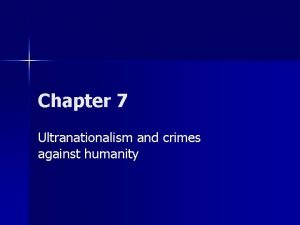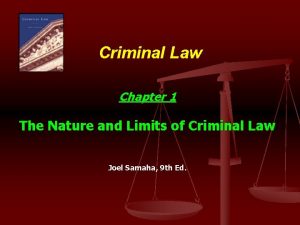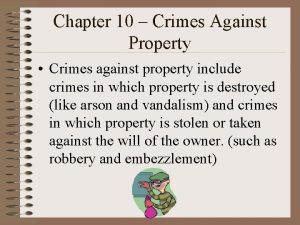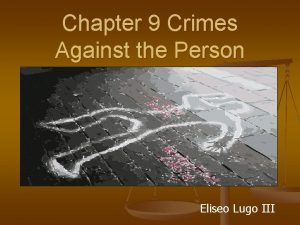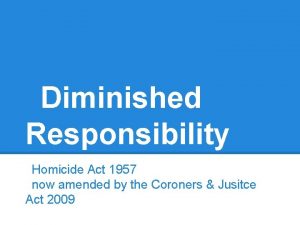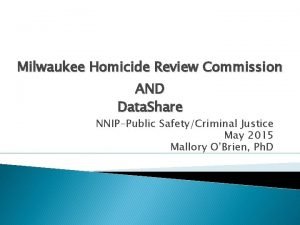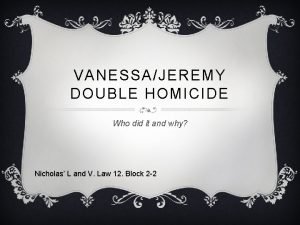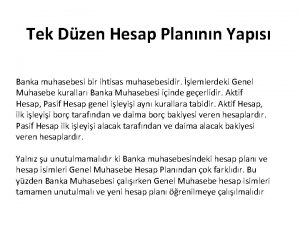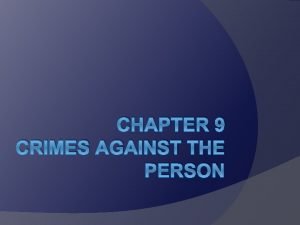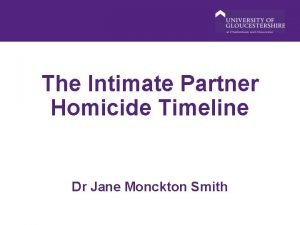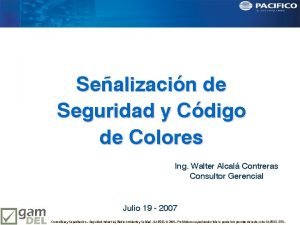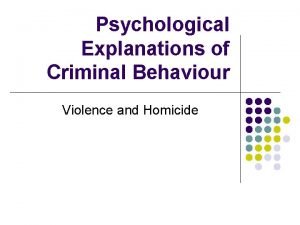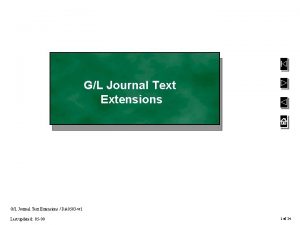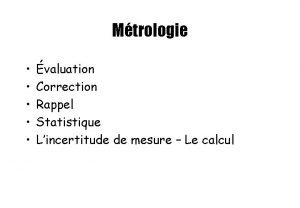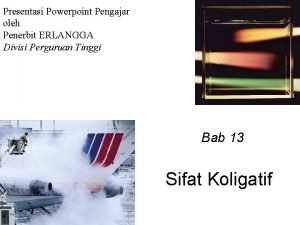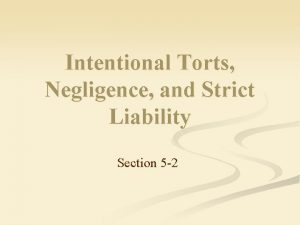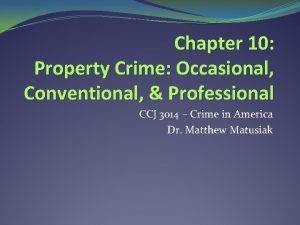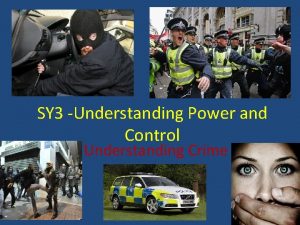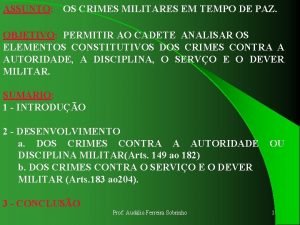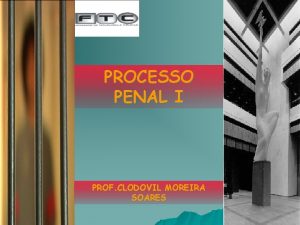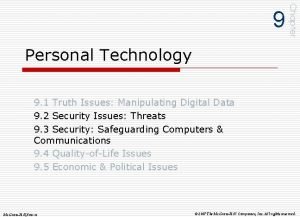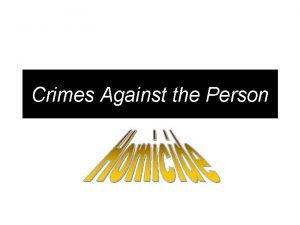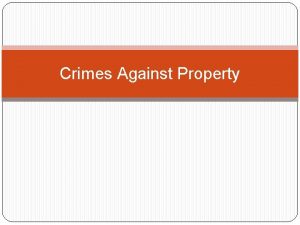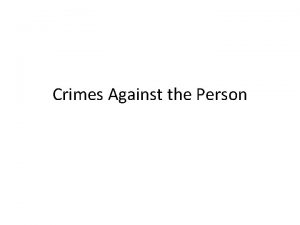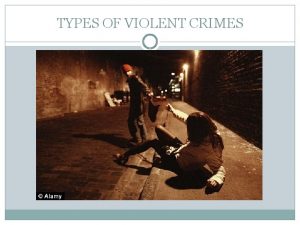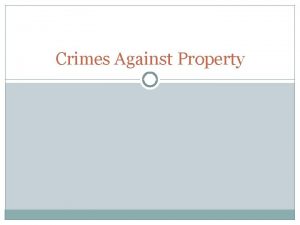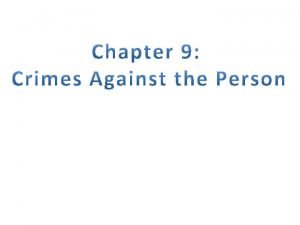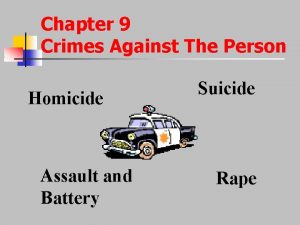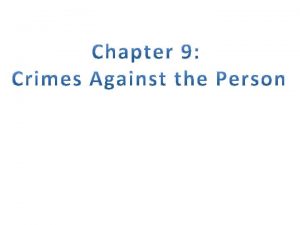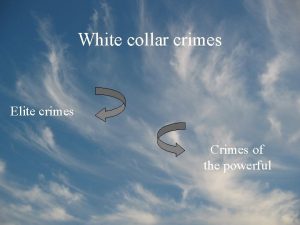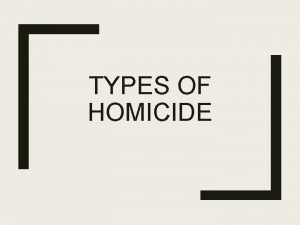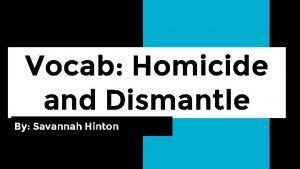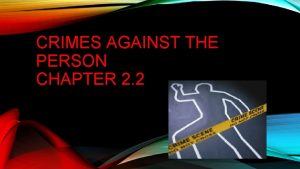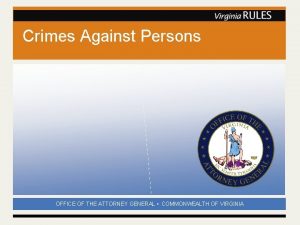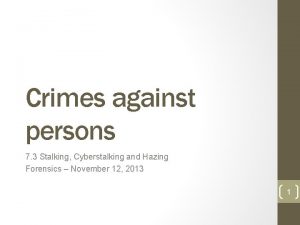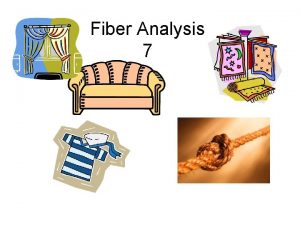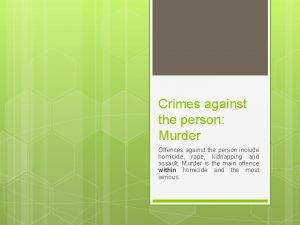CRIMES AGAINST PERSONS HOMICIDE 9 A 32 010
















































- Slides: 48

CRIMES AGAINST PERSONS

HOMICIDE 9 A. 32. 010 Homicide defined. Homicide is the killing of a human being by the act, procurement, or omission of another, death occurring at any time, and is either (1) murder (2) homicide by abuse (3) manslaughter (4) excusable homi cide (5) justifiable homicide

HOMICIDE 9 A. 32. 020 Premeditation—Limitations. The premeditation required in order to support a conviction of the crime of murder in the first degree must involve more than a moment in point of time.

HOMICIDE 9 A. 32. 030 Murder in the first degree. (1) A person is guilty of murder in the first degree when: (a) With a premeditated intent to cause the death of another person, he or she causes the death of such person or of a third person; or (b) Under circumstances manifesting an extreme indif ference to human life, he or she engages in conduct which creates a grave risk of death to any person, and thereby causes the death of a person; or (c) He or she commits or attempts to commit the crime of either (1) robbery in the first or second degree, (2) rape in the first or second degree, (3) burglary in the first degree, (4) arson in the first or second degree, or (5) kidnapping in the first or second degree, and in the course of or in furtherance of such crime or in immediate flight therefrom, he or she, or another participant, causes the death of a person other than one of the participants: Except that in any prosecution under this subdivision (1)(c) in which the defendant was not the only participant in the underlying crime, if established by the defendant by a preponderance of the evidence, it is a defense that the defendant: 9 A. 32. 040 Title 9 A RCW: Washington Criminal Code [Title 9 A RCW—page 12] 2012

HOMICIDE (CONT’D) 9 A. 32. 030 (i) Did not commit the homicidal act or in any way solicit, request, command, importune, cause, or aid the com mission thereof; and (ii) Was not armed with a deadly weapon, or any instru ment, article, or substance readily capable of causing death or serious physical injury; and (iii) Had no reasonable grounds to believe that any other participant was armed with such a weapon, instrument, arti cle, or substance; and (iv) Had no reasonable grounds to believe that any other participant intended to engage in conduct likely to result in death or serious physical injury. (2) Murder in the first degree is a class A felony.

HOMICIDE (CONT’D) 9 A. 32. 040 Murder in the first degree—Sentence. Notwithstanding RCW 9 A. 32. 030(2), any person convicted of the crime of murder in the first degree shall be sentenced to life imprisonment.

HOMICIDE (CONT’D) 9 A. 32. 050 Murder in the second degree. (1) A person is guilty of murder in the second degree when: (a) With intent to cause the death of another person but without premeditation, he or she causes the death of such per son or of a third person; or (b) He or she commits or attempts to commit any felony, including assault, other than those enumerated in RCW 9 A. 32. 030(1)(c), and, in the course of and in furtherance of such crime or in immediate flight therefrom, he or she, or another participant, causes the death of a person other than one of the participants; except that in any prosecution under this subdivision (1)(b) in which the defendant was not the only participant in the underlying crime, if established by the defendant by a preponderance of the evidence, it is a defense that the defendant: (i) Did not commit the homicidal act or in any way solicit, request, command, importune, cause, or aid the com mission thereof; and

HOMICIDE (CONT’D) 9 A. 32. 050 (ii) Was not armed with a deadly weapon, or any instru ment, article, or substance readily capable of causing death or serious physical injury; and (iii) Had no reasonable grounds to believe that any other participant was armed with such a weapon, instrument, arti cle, or substance; and (iv) Had no reasonable grounds to believe that any other participant intended to engage in conduct likely to result in death or serious physical injury. (2) Murder in the second degree is a class A felony.

HOMICIDE (CONT’D) 9 A. 32. 055 Homicide by abuse. (1) A person is guilty of homicide by abuse if, under circumstances manifesting an extreme indifference to human life, the person causes the death of a child or person under sixteen years of age, a devel opmentally disabled person, or a dependent adult, and the person has previously engaged in a pattern or practice of assault or torture of said child, person under sixteen years of age, developmentally disabled person, or dependent person. (2) As used in this section, "dependent adult" means a person who, because of physical or mental disability, or because of extreme advanced age, is dependent upon another person to provide the basic necessities of life. (3) Homicide by abuse is a class A felony.

HOMICIDE (CONT’D) 9 A. 32. 070 Manslaughter in the second degree. (1) A person is guilty of manslaughter in the second degree when, with criminal negligence, he or she causes the death of another person. (2) Manslaughter in the second degree is a class B fel ony.

ASSAULT 9 A. 36. 011 Assault in the first degree. (1) A person is guilty of assault in the first degree if he or she, with intent to inflict great bodily harm: (a) Assaults another with a firearm or any deadly weapon or by any force or means likely to produce great bodily harm or death; or (b) Administers, exposes, or transmits to or causes to be taken by another, poison, the human immunodeficiency virus as defined in chapter 70. 24 RCW, or any other destructive or noxious substance; or (c) Assaults another and inflicts great bodily harm. (2) Assault in the first degree is a class A felony.

ASSAULT (CONT’D) 9 A. 36. 021 Assault in the second degree. (1) A person is guilty of assault in the second degree if he or she, under cir cumstances not amounting to assault in the first degree: (a) Intentionally assaults another and thereby recklessly inflicts substantial bodily harm; or (b) Intentionally and unlawfully causes substantial bodily harm to an unborn quick child by intentionally and unlawfully inflicting any injury upon the mother of such child; or

ASSAULT (CONT’D) 9 A. 36. 021 Assault in the second degree. (c) Assaults another with a deadly weapon; or (d) With intent to inflict bodily harm, administers to or causes to be taken by another, poison or any other destructive or noxious substance; or (e) With intent to commit a felony, assaults another; or

ASSAULT (CONT’D) 9 A. 36. 021 Assault in the second degree. (f) Knowingly inflicts bodily harm which by design causes such pain or agony as to be the equivalent of that pro duced by torture; or (g) Assaults another by strangulation or suffocation. (2)(a) Except as provided in (b) of this subsection, assault in the second degree is a class B felony. (b) Assault in the second degree with a finding of sexual motivation under RCW 9. 94 A. 835 or 13. 40. 135 is a class A felony.

ASSAULT (CONT’D) 9 A. 36. 031 Assault in the third degree. (1) A person is guilty of assault in the third degree if he or she, under circum stances not amounting to assault in the first or second degree: (a) With intent to prevent or resist the execution of any lawful process or mandate of any court officer or the lawful apprehension or detention of himself, herself, or another per son, assaults another; or (b) Assaults a person employed as a transit operator or driver, the immediate supervisor of a transit operator or driver, a mechanic, or a security officer, by a public or private transit company or a contracted transit service provider, while that person is performing his or her official duties at the time of the assault; or

ASSAULT (CONT’D) 9 A. 36. 031 Assault in the third degree. (c) Assaults a school bus driver, the immediate supervi sor of a driver, a mechanic, or a security officer, employed by a school district transportation service or a private company under contract for transportation services with a school dis trict, while the person is performing his or her official duties at the time of the assault; or (d) With criminal negligence, causes bodily harm to another person by means of a weapon or other instrument or thing likely to produce bodily harm; or (e) Assaults a firefighter or other employee of a fire department, county fire marshal’s office, county fire preven tion bureau, or fire protection district who was performing his or her official duties at the time of the assault; or

ASSAULT (CONT’D) 9 A. 36. 031 Assault in the third degree. (f) With criminal negligence, causes bodily harm accom panied by substantial pain that extends for a period sufficient to cause considerable suffering; or (g) Assaults a law enforcement officer or other employee of a law enforcement agency who was performing his or her official duties at the time of the assault; or (h) Assaults a peace officer with a projectile stun gun; or

ASSAULT (CONT’D) 9 A. 36. 031 Assault in the third degree. (i) Assaults a nurse, physician, or health care provider who was performing his or her nursing or health care duties at the time of the assault. For purposes of this subsection: "Nurse" means a person licensed under chapter 18. 79 RCW; "physician" means a person licensed under chapter 18. 57 or 18. 71 RCW; and "health care provider" means a person certi fied under chapter 18. 71 or 18. 73 RCW who performs emer gency medical services or a person regulated under Title 18 RCW and employed by, or contracting with, a hospital licensed under chapter 70. 41 RCW; or

ASSAULT (CONT’D) 9 A. 36. 031 Assault in the third degree. (j) Assaults a judicial officer, court related employee, county clerk, or county clerk’s employee, while that person is performing his or her official duties at the time of the assault or as a result of that person’s employment within the judicial system. For purposes of this subsection, "court related employee" includes bailiffs, court reporters, judicial assis tants, court managers’ employees, and any other employee, regardless of title, who is engaged in equiv alent functions (2) Assault in the third degree is a class C felony.

ASSAULT (CONT’D) 9 A. 36. 041 Assault in the fourth degree. (1) A person is guilty of assault in the fourth degree if, under circum stances not amounting to assault in the first, second, or third degree, or custodial assault, he or she assaults another. (2) Assault in the fourth degree is a gross misdemeanor.

ASSAULT (CONT’D) 9 A. 36. 045 Drive-by shooting. (1) A person is guilty of drive by shooting when he or she recklessly discharges a fire arm as defined in RCW 9. 41. 010 in a manner which creates a substantial risk of death or serious physical injury to another person and the discharge is either from a motor vehicle or from the immediate area of a motor vehicle that was used to transport the shooter or the firearm, or both, to the scene of the discharge. (2) A person who unlawfully discharges a firearm from a moving motor vehicle may be inferred to have engaged in reckless conduct, unless the discharge is shown by evidence satisfactory to the trier of fact to have been made without such recklessness. (3) Drive by shooting is a class B felony

ASSAULT (CONT’D) 9 A. 36. 050 Reckless endangerment. (1) A person is guilty of reckless endangerment when he or she recklessly engages in conduct not amounting to drive by shooting but that creates a substantial risk of death or serious physical injury to another person. (2) Reckless endangerment is a gross misdemeanor.

ASSAULT (CONT’D) 9 A. 36. 060 Promoting a suicide attempt. (1) A person is guilty of promoting a suicide attempt when he or she know ingly causes or aids another person to attempt suicide. (2) Promoting a suicide attempt is a class C felony.

ASSAULT (CONT’D) 9 A. 36. 070 Coercion. (1) A person is guilty of coercion if by use of a threat he or she compels or induces a person to engage in conduct which the latter has a legal right to abstain from, or to abstain from conduct which he or she has a legal right to engage in. (2) "Threat" as used in this section means: (a) To communicate, directly or indirectly, the intent immediately to use force against any person who is present at the time; or (b) Threats as defined in *RCW 9 A. 04. 110(27) (a), (b), or (c). (3) Coercion is a gross misdemeanor.

ASSAULT (CONT’D) 9 A. 36. 078 Malicious harassment—Finding. The leg islature finds that crimes and threats against persons because of their race, color, religion, ancestry, national origin, gender, sexual orientation, or mental, physical, or sensory handicaps are serious and increasing. The legislature also finds that crimes and threats are often directed against interracial cou ples and their children or couples of mixed religions, colors, ancestries, or national origins because of bias and bigotry against the race, color, religion, ancestry, or national origin of one person in the couple or family. The legislature finds that the state interest in preventing crimes and threats motivated by bigotry and bias goes beyond the state interest in prevent ing other felonies or misdemeanors such as criminal trespass, malicious mischief, assault, or other crimes that are not moti vated by hatred, bigotry, and bias, and that prosecution of those other crimes inadequately protects citizens from crimes and threats motivated by bigotry and bias. Therefore, the leg islature finds that protection of those citizens from threats of harm due to bias and bigotry is a compelling state interest.

ASSAULT (CONT’D) 9 A. 36. 078 Malicious harassment—Finding. The legislature also finds that in many cases, certain dis crete words or symbols are used to threaten the victims. Those discrete words or symbols have historically or tradi tionally been used to connote hatred or threats towards mem bers of the class of which the victim or a member of the vic tim’s family or household is a member. In particular, the leg islature finds that cross burnings historically and traditionally have been used to threaten, terrorize, intimidate, and harass African Americans and their families. Cross burnings often preceded lynchings, murders, burning of homes, and other acts of terror. Further, Nazi swastikas historically and tradi tionally have been used to threaten, terrorize, intimidate, and harass Jewish people and their families. Swastikas symbolize the massive destruction of the Jewish population, commonly known as the holocaust. Therefore, the legislature finds that any person who burns or attempts to burn a cross or displays a swastika on the property of the victim or burns a cross or displays a swastika as part of a series of acts directed towards a particular person, the person’s family or household mem bers, or a particular group, knows or reasonably should know that the cross burning or swastika may create a reasonable fear of harm in the mind of the person, the person’s family and household members, or the group.

ASSAULT (CONT’D) 9 A. 36. 078 Malicious harassment—Finding. The legislature also finds that a hate crime committed against a victim because of the victim’s gender may be iden tified in the same manner that a hate crime committed against a victim of another protected group is identified. Affirmative indications of hatred towards gender as a class is the predom inant factor to consider. Other factors to consider include the perpetrator’s use of language, slurs, or symbols expressing hatred towards the victim’s gender as a class; the severity of the attack including mutilation of the victim’s sexual organs; a history of similar attacks against victims of the same gender by the perpetrator or a history of similar incidents in the same area; a lack of provocation; an absence of any other apparent motivation; and common sense.

ASSAULT (CONT’D) 9 A. 36. 080 Malicious harassment—Definition and criminal penalty. (1) A person is guilty of malicious harass ment if he or she maliciously and intentionally commits one of the following acts because of his or her perception of the victim’s race, color, religion, ancestry, national origin, gen der, sexual orientation, or mental, physical, or sensory hand icap: (a) Causes physical injury to the victim or another per son; (b) Causes physical damage to or destruction of the prop erty of the victim or another person; or

ASSAULT (CONT’D) 9 A. 36. 080 Malicious harassment—Definition and criminal penalty. (c) Threatens a specific person or group of persons and places that person, or members of the specific group of per sons, in reasonable fear of harm to person or property. The fear must be a fear that a reasonable person would have under all the circumstances. For purposes of this section, a "reason able person" is a reasonable person who is a member of the victim’s race, color, religion, ancestry, national origin, gen der, or sexual orientation, or who has the same mental, phys ical, or sensory handicap as the victim. Words alone do not constitute malicious harassment unless the context or circum stances surrounding the words indicate the words are a threat. Threatening words do not constitute malicious harassment if it is apparent to the victim that the person does not have the ability to carry out the threat.

ASSAULT (CONT’D) 9 A. 36. 080 Malicious harassment—Definition and criminal penalty. (2) In any prosecution for malicious harassment, unless evidence exists which explains to the trier of fact’s satisfac tion that the person did not intend to threaten the victim or victims, the trier of fact may infer that the person intended to threaten a specific victim or group of victims because of the person’s perception of the victim’s or victims’ race, color, religion, ancestry, national origin, gender, sexual orientation, or mental, physical, or sensory handicap if the person com mits one of the following acts: (a) Burns a cross on property of a victim who is or whom the actor perceives to be of African American heritage; or

ASSAULT (CONT’D) 9 A. 36. 080 Malicious harassment—Definition and criminal penalty. (b) Defaces property of a victim who is or whom the actor perceives to be of Jewish heritage by defacing the prop erty with a swastika. This subsection only applies to the creation of a reason able inference for evidentiary purposes. This subsection does not restrict the state’s ability to prosecute a person under sub section (1) of this section when the facts of a particular case do not fall within (a) or (b) of this subsection. (3) It is not a defense that the accused was mistaken that the victim was a member of a certain race, color, religion, ancestry, national origin, gender, or sexual orientation, or had a mental, physical, or sensory handicap.

ASSAULT (CONT’D) 9 A. 36. 080 Malicious harassment—Definition and criminal penalty. (4) Evidence of expressions or associations of the accused may not be introduced as substantive evidence at trial unless the evidence specifically relates to the crime charged. Nothing in this chapter shall affect the rules of evi dence governing impeachment of a witness. (5) Every person who commits another crime during the commission of a crime under this section may be punished and prosecuted for the other crime separately.

ASSAULT (CONT’D) 9 A. 36. 080 Malicious harassment—Definition and criminal penalty. (6) For the purposes of this section: (a) "Sexual orientation" has the same meaning as in RCW 49. 60. 040. (b) "Threat" means to communicate, directly or indi rectly, the intent to: (i) Cause bodily injury immediately or in the future to the person threatened or to any other person; or (ii) Cause physical damage immediately or in the future to the property of a person threatened or that of any other per son.

ASSAULT (CONT’D) 9 A. 36. 080 Malicious harassment—Definition and criminal penalty. (7) Malicious harassment is a class C felony. (8) The penalties provided in this section for malicious harassment do not preclude the victims from seeking any other remedies otherwise available under law. (9) Nothing in this section confers or expands any civil rights or protections to any group or class identified under this section, beyond those rights or protections that exist under the federal or state Constitution or the civil laws of the state of Washington.

ASSAULT (CONT’D) 9 A. 36. 083 Malicious harassment—Civil action. In addition to the criminal penalty provided in RCW 9 A. 36. 080 for committing a crime of malicious harassment, the victim may bring a civil cause of action for malicious harassment against the harasser. A person may be liable to the victim of malicious harassment for actual damages, punitive damages of up to ten thousand dollars, and reasonable attorneys’ fees and costs incurred in bringing the action.

ASSAULT (CONT’D) 9 A. 36. 090 Threats against governor or family. (1) Whoever knowingly and willfully deposits for conveyance in the mail or for a delivery from any post office or by any letter carrier any letter, paper, writing, print, missive, or document containing any threat to take the life of or to inflict bodily harm upon the governor of the state or his or her immediate family, the governor elect, the lieutenant governor, other officer next in the order of succession to the office of gover nor of the state, or the lieutenant governor elect, or know ingly and willfully otherwise makes any such threat against the governor, governor elect, lieutenant governor, other offi cer next in the order of succession to the office of governor, or lieutenant governor elect, shall be guilty of a class C fel ony.

ASSAULT (CONT’D) 9 A. 36. 090 Threats against governor or family. (2) As used in this section, the term "governor elect" and "lieutenant governor elect" means such persons as are the successful candidates for the offices of governor and lieuten ant governor, respectively, as ascertained from the results of the general election. As used in this section, the phrase "other officer next in the order of succession to the office of governor" means the person other than the lieutenant governor next in order of succession to the office of governor under Article 3, section 10 of the state Constitution. (3) The Washington state patrol may investigate for vio lations of this section.

ASSAULT (CONT’D) 9 A. 36. 100 Custodial assault. (1) A person is guilty of custodial assault if that person is not guilty of an assault in the first or second degree and where the person: (a) Assaults a full or part time staff member or volunteer, any educational personnel, any personal service provider, or any vendor or agent thereof at any juvenile corrections insti tution or local juvenile detention facilities who was perform ing official duties at the time of the assault; (b) Assaults a full or part time staff member or volun teer, any educational personnel, any personal service pro vider, or any vendor or agent thereof at any adult corrections institution or local adult detention facilities who was per forming official duties at the time of the assault;

ASSAULT (CONT’D) 9 A. 36. 100 Custodial assault. (c)(i) Assaults a full or part time community correction officer while the officer is performing official duties; or (ii) Assaults any other full or part time employee who is employed in a community corrections office while the employee is performing official duties; or (d) Assaults any volunteer who was assisting a person described in (c) of this subsection at the time of the assault. (2) Custodial assault is a class C felony.

ASSAULT (CONT’D) 9 A. 36. 120 Assault of a child in the first degree. (1) A person eighteen years of age or older is guilty of the crime of assault of a child in the first degree if the child is under the age of thirteen and the person: (a) Commits the crime of assault in the first degree, as defined in RCW 9 A. 36. 011, against the child; or (b) Intentionally assaults the child and either: (i) Recklessly inflicts great bodily harm; or

ASSAULT (CONT’D) 9 A. 36. 120 Assault of a child in the first degree. (ii) Causes substantial bodily harm, and the person has previously engaged in a pattern or practice either of (A) assaulting the child which has resulted in bodily harm that is greater than transient physical pain or minor temporary marks, or (B) causing the child physical pain or agony that is equivalent to that produced by torture. (2) Assault of a child in the first degree is a class A fel ony.

ASSAULT (CONT’D) 9 A. 36. 130 Assault of a child in the second degree. (1) A person eighteen years of age or older is guilty of the crime of assault of a child in the second degree if the child is under the age of thirteen and the person: (a) Commits the crime of assault in the second degree, as defined in RCW 9 A. 36. 021, against a child; or

ASSAULT (CONT’D) 9 A. 36. 130 Assault of a child in the second degree. (b) Intentionally assaults the child and causes bodily harm that is greater than transient physical pain or minor tem porary marks, and the person has previously engaged in a pat tern or practice either of (i) assaulting the child which has resulted in bodily harm that is greater than transient pain or minor temporary marks, or (ii) causing the child physical pain or agony that is equivalent to that produced by torture. (2) Assault of a child in the second degree is a class B felony.

ASSAULT (CONT’D) 9 A. 36. 140 Assault of a child in the third degree. (1) A person eighteen years of age or older is guilty of the crime of assault of a child in the third degree if the child is under the age of thirteen and the person commits the crime of assault in the third degree as defined in RCW 9 A. 36. 031(1) (d) or (f) against the child. (2) Assault of a child in the third degree is a class C fel ony.

ASSAULT (CONT’D) 9 A. 36. 150 Interfering with the reporting of domestic violence. (1) A person commits the crime of interfering with the reporting of domestic violence if the person: (a) Commits a crime of domestic violence, as defined in RCW 10. 99. 020; and (b) Prevents or attempts to prevent the victim of or a wit ness to that domestic violence crime from calling a 911 emer gency communication system, obtaining medical assistance, or making a report to any law enforcement official. (2) Commission of a crime of domestic violence under subsection (1) of this section is a necessary element of the crime of interfering with the reporting of domestic violence. (3) Interference with the reporting of domestic violence is a gross misdemeanor.

ASSAULT (CONT’D) 9 A. 36. 160 Failing to summon assistance. A person is guilty of the crime of failing to summon assistance if: (1) He or she was present when a crime was committed against another person; and (2) He or she knows that the other person has suffered substantial bodily harm as a result of the crime committed against the other person and that the other person is in need of assistance; and (3) He or she could reasonably summon assistance for the person in need without danger to himself or herself and without interference with an important duty owed to a third party; and

ASSAULT (CONT’D) 9 A. 36. 160 Failing to summon assistance. A person is guilty of the crime of failing to summon assistance if: (4) He or she fails to summon assistance for the person in need; and (5) Another person is not summoning or has not sum moned assistance for the person in need of such assistance

ASSAULT (CONT’D) Failing to summon assistance - Penalty. A violation of RCW 9 A. 36. 160 is a misdemeanor. 9 A. 36. 161
 A person's trash is another person's treasure
A person's trash is another person's treasure How does ultranationalism lead to crimes against humanity
How does ultranationalism lead to crimes against humanity What are the crimes against public order?
What are the crimes against public order? Chapter 10 crimes against property
Chapter 10 crimes against property What are the crimes against public order?
What are the crimes against public order? Crimes against society
Crimes against society Street law chapter 9 crimes against the person
Street law chapter 9 crimes against the person Homicide act 1957
Homicide act 1957 Milwaukee homicide review commission
Milwaukee homicide review commission Double homicide
Double homicide Paulo frayer
Paulo frayer Pgs281-010
Pgs281-010 Ktkp
Ktkp 010 kasa hesabı
010 kasa hesabı Imvigor 010
Imvigor 010 Homicide example scenario
Homicide example scenario Arizona homicide investigators association
Arizona homicide investigators association Inflamacion
Inflamacion Dr jane monckton smith 8 stages
Dr jane monckton smith 8 stages Worte haben kraft
Worte haben kraft Khi n
Khi n Colores en ing
Colores en ing Besaran pokok adalah
Besaran pokok adalah Mafia hula hoops 1959
Mafia hula hoops 1959 Overt vs covert behavior
Overt vs covert behavior X cube + y cube
X cube + y cube Keynote-010
Keynote-010 Dr todd stoner
Dr todd stoner H3387 010 01 - hmo
H3387 010 01 - hmo Da0583-010
Da0583-010 N-010
N-010 Correction
Correction Nstm 300 rev 10
Nstm 300 rev 10 Keynote-010
Keynote-010 Dss soc
Dss soc Berapakah titik beku 0 010 m k2so4
Berapakah titik beku 0 010 m k2so4 Nom-010-tur-2001
Nom-010-tur-2001 Strict liability tort
Strict liability tort Crimes contra a economia popular
Crimes contra a economia popular Occasional property crimes
Occasional property crimes Crimes sy
Crimes sy Expressive crimes definition
Expressive crimes definition How does sociology interpret hate crimes
How does sociology interpret hate crimes Puritan stocks punishment
Puritan stocks punishment Cscw
Cscw Quais são os crimes militares em tempo de paz
Quais são os crimes militares em tempo de paz Strict liability crimes
Strict liability crimes Crimes habituais
Crimes habituais Types of computer crimes
Types of computer crimes

